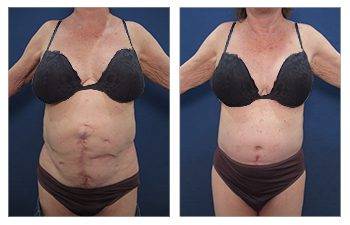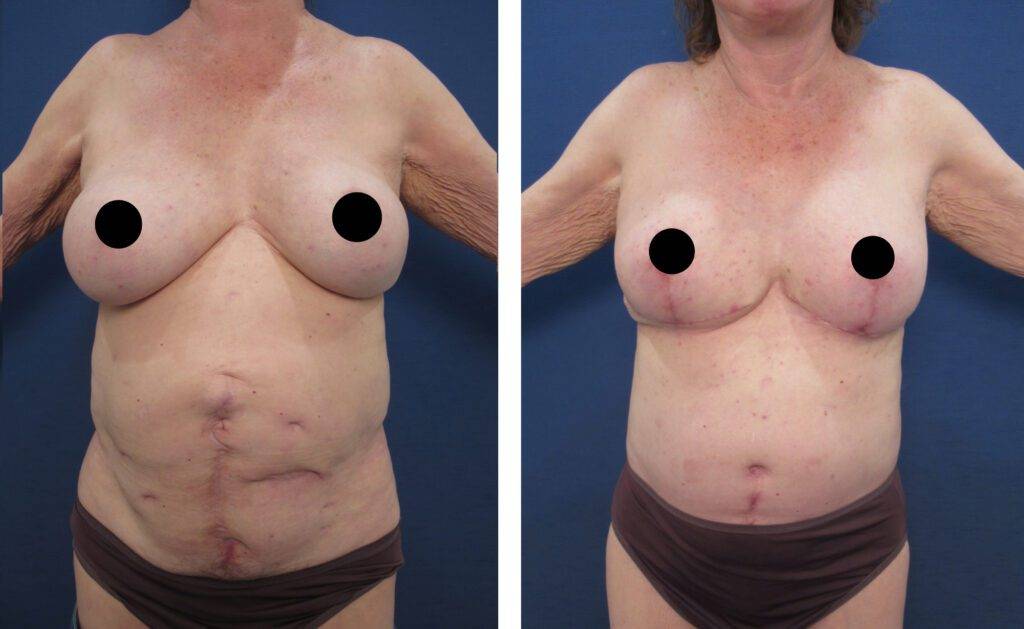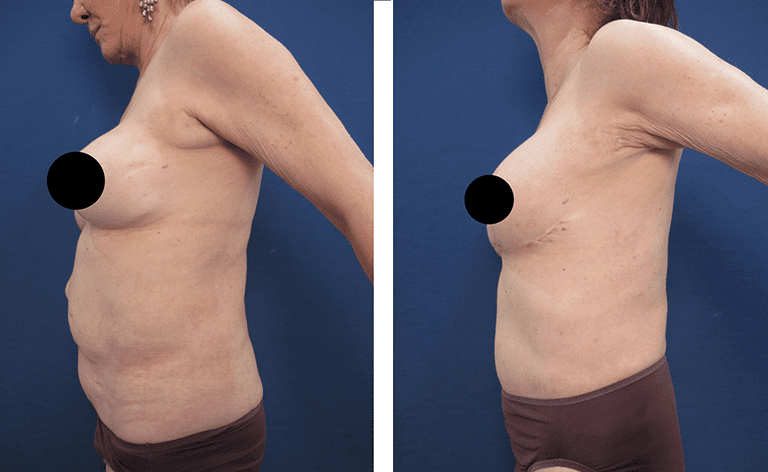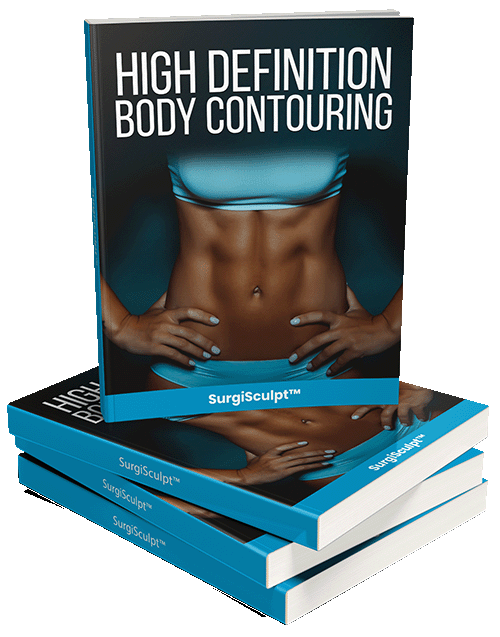




Introduction: Eliminating a bulging belly with a tummy tuck
Eliminating a bulging belly is an essential part of a tummy tuck. The bulging of the belly has been termed diastasis recti and describes the stretching out of both the abdominal muscles as well as the ligaments that connect the muscles together.
The major muscle group of the abdomen includes the rectus muscles that are aligned in two vertical columns that are connected by a vertical ligament called the linea alba.
Stretching out of the linea alba will result in a bulging belly that can be eliminated with a tummy tuck. Stretching out of the linea alba is directly related to an increase in intra-abdominal volumes that result in increased pressure against the abdominal wall.
In addition to stretching out of the linea alba, the rectus muscles themselves can also stretch out and literally thin out. The bulging of the belly involving both the rectus muscles and linea alba stretching comprise diastasis recti.
Eliminating a bulging belly with a tummy tuck involves directly tightening the linea alba centrally, thereby bringing the two vertical columns of rectus muscles together. The tightening of the linea alba is achieved with a running stitching technique that extends from the rib cage down to the pubic region.
This stitching technique is performed much like a corset. Since the belly button needs to be kept uncovered for later reinsetting, the corset must be seen as two independent runs one above and another below the belly button.
Independent tightening of the bulging belly allows for differential tightening of the abdominal wall above and below the belly button. This is critical in female patients who should be tightened more aggressively above the belly button than below the belly button to create a gentle concave upper abdominal contour and a gentle convex lower abdominal contour.
Eliminating a bulging belly with a tummy tuck is required when patients demonstrate an abdominal contour that looks like they are bloated. Patients can be demonstrated the improvement that will be achieved with a diastasis recti repair by having them stick out and then sucking in their bellies.
Most women inherently suck in their abs to make their silhouette look better, but after their diastasis recti repair they will always look sucked in even when they are relaxed.
We live in an era where body positivity is celebrated, yet the desire for an ideal physique remains. The abdomen, in particular, is a concern for many. Bulges, whether from pregnancy, aging, genetics, or weight changes, can become sources of distress. A tummy tuck, a procedure that has garnered much attention over the years, offers a solution for many. In this comprehensive guide, we’ll delve deep into understanding and potentially eliminating a bulging belly with a tummy tuck.
Understanding the Cause of a Bulging Belly
The human body undergoes numerous changes over a lifetime. Factors like pregnancy, genetics, aging, and significant weight fluctuations can contribute to the belly’s bulging appearance. While diet and exercise are the first lines of defense against excess weight, they sometimes fall short in addressing sagging skin and stretched abdominal muscles.
The Anatomy of a Bulge
The skin, especially around the abdomen, loses elasticity over time. This phenomenon is further exacerbated by rapid weight gain or loss, leading to stretched skin. Beneath the skin, abdominal muscles can become separated—a condition known as diastasis recti. This muscle separation is common after pregnancy and can result in a protruding belly.
The Emotional and Physical Toll
It’s not just about aesthetics. A protruding belly can lead to physical discomforts, such as back pain due to altered posture or skin irritations from overhanging folds. Emotionally, self-esteem can take a hit, leading to reduced confidence and social withdrawal.
Diving Deep into the Tummy Tuck Procedure
Defining the Tummy Tuck
A tummy tuck, or abdominoplasty, isn’t just a cosmetic procedure—it’s a transformative journey. It entails the removal of excess fat and skin from the abdominal region and the tightening of abdominal muscles. The result is a sleeker, more contoured midsection.
Types of Tummy Tucks
There isn’t a one-size-fits-all approach. Depending on individual needs, surgeons might recommend:
- . Full Tummy Tuck: Best for those with a significant amount of excess skin or weakened abdominal muscles. It addresses the entire abdominal area.
- . Mini Tummy Tuck: Suited for individuals whose primary concerns lie below the navel. It’s less invasive and has a shorter recovery time.
- . Extended Tummy Tuck: This option goes beyond the traditional tummy tuck, addressing excess skin on the flanks and lower back.
The Surgical Journey
A tummy tuck begins with an incision, typically from hip bone to hip bone, just above the pubic area. The surgeon then removes excess skin, tightens muscles, and sometimes employs liposuction to eliminate stubborn fat. Once the desired contour is achieved, the incisions are closed, often leaving a scar that’s easily concealed beneath underwear or a swimsuit.
Preparation and Post-operative Care: A Roadmap to Success
Preparing Mind and Body
A successful tummy tuck journey begins before entering the operating room. Potential patients should:
- . Achieve a stable weight.
- . Cease smoking, as it can impede healing.
- . Discuss all medications and supplements with their surgeon.
- . Undergo a thorough health evaluation to ensure they’re suitable candidates.
Recovery: Patience is Key
Post-operative care greatly influences the results. During the recovery phase:
- . Expect to take time off from work and physical activities.
- . Manage pain and discomfort with prescribed medications.
- . Wear compression garments to reduce swelling and support healing.
- . Attend follow-up appointments and promptly address any concerns with the surgeon.
Risks, Realities, and Rewards
Every surgical procedure carries inherent risks. For tummy tucks, these might include scarring, infection, poor wound healing, and anesthesia reactions. However, by selecting a certified and experienced surgeon, these risks can be minimized.
Furthermore, setting realistic expectations is paramount. While a tummy tuck provides noticeable improvements, the final appearance might take months to materialize due to swelling. Long-term success hinges on maintaining a stable weight and a healthy lifestyle.
Comparing Alternatives
While tummy tucks offer a definitive solution, some might consider non-surgical alternatives:
- CoolSculpting: Uses cold temperatures to break down fat cells.
- Laser Treatments: Employ heat to stimulate collagen production and skin tightening.
- Ultrasound Therapy: Targets fat cells with ultrasound waves.
Each method has its merits and limitations. A thorough consultation with a cosmetic specialist can guide decision-making.
In Conclusion: Eliminating a bulging belly with a tummy tuck
A tummy tuck represents more than physical transformation—it’s a journey of empowerment, confidence, and self-renewal. Whether battling post-pregnancy changes, the aftermath of significant weight loss, or the inexorable march of time, a tummy tuck can be the chapter where one regains control over their abdominal story.
To explore further, esteemed platforms like the American Society of Plastic Surgeons or WebMD offer a wealth of information on the topic. Informed decisions, backed by reputable sources and professional consultations, pave the way for successful outcomes in the realm of cosmetic enhancements.n
72-year-old female status post full abdominoplasty and breast augmentation revision.
